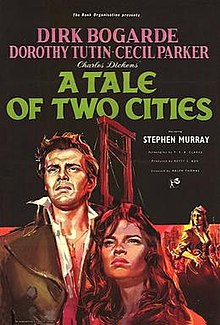A Tale of Two Cities (1958 film)
| A Tale of Two Cities | |
|---|---|
 Original UK cinema poster | |
| Directed by | Ralph Thomas |
| Screenplay by | T. E. B. Clarke |
| Based on | A Tale of Two Cities 1859 novel by Charles Dickens |
| Produced by | Betty E. Box |
| Starring | Dirk Bogarde Dorothy Tutin Cecil Parker |
| Cinematography | Ernest Steward |
| Edited by | Alfred Roome |
| Music by | Richard Addinsell |
Production company | |
| Distributed by | Rank Film Distributors |
Release date |
|
Running time | 117 minutes |
| Country | United Kingdom |
| Language | English |
| Budget | £320,000[1] |
A Tale of Two Cities is a 1958 British film directed by Ralph Thomas and starring Dirk Bogarde and Dorothy Tutin. It is a period drama based on parts of Charles Dickens' novel A Tale of Two Cities (1859).
Plot
Sydney Carton, an alcoholic English lawyer, discovers that Charles Darnay, a man he once defended, is a French aristocrat trying to escape the French Revolution. While he envies the man over the love of a woman, Lucie Manette, his conscience is pricked and he resolves to help him escape the guillotine.
Cast
- Dirk Bogarde as Sydney Carton
- Dorothy Tutin as Lucie Manette
- Paul Guers as Charles Darnay (Voice dubbed by Tim Turner – uncredited)
- Marie Versini as Marie Gabelle
- Ian Bannen as Gabelle
- Alfie Bass as Jerry Cruncher
- Cecil Parker as Jarvis Lorry
- Stephen Murray as Dr. Manette
- Athene Seyler as Miss Pross
- Ernest Clark as Stryver
- Rosalie Crutchley as Madame Defarge
- Freda Jackson as the Vengeance
- Duncan Lamont as Ernest Defarge
- Leo McKern as Attorney General-Old Bailey
- Donald Pleasence as John Barsad
- Christopher Lee as Marquis St. Evremonde
- Sam Kydd as Coachman
Production
Ralph Thomas insisted on the film being shot in black and white as he felt the book "was written in black and white, and it's got to be made in black and white."[1] He was influenced by a French film Casque d'Or set in a similar period which was in black and white.[2]
Thomas later said this was a mistake and the commercial after-life of the film would have been stronger if it had been in colour. He said the film "was very self indulgent because I wouldn't listen to advice. It's dangerous to have fashion and power and I was fashionable then."[1]
The film was the most expensive British production of its year.[3]
Filming started 3 July 1957 at Bourges in France for four weeks of location work. The film was shot in the Loire Valley in France, because it was the only place without telegraph poles. Several thousand American soldiers posted nearby in Orléans were used as extras. Shooting took six weeks. "The only way we were able to finish a film this ambitious on such a modest budget was by using a regular crew, so there were no fights, we just tackled it and went on until the finish", said Thomas.[1]
Critical reception
The Guardian called it "a plain and honest version which makes a decent attempt at putting the complexities of the story into two hours."[4]
The New York Times wrote "it is mostly a bloodless and sober, albeit meticulous account that is spun here";[5] The Monthly Film Bulletin called it "an eminently respectable but scarcely distinguished addition to the list of filmed Dickens", noting that Rosalie Crutchley's "tirelessly bloodthirsty Mme Defarge – blatantly theatrical but full of gusto – is particularly welcome. This kind of vividness and life is exactly what the film as a whole lacks.[6] However, AllMovie found "a respectable adaptation with a sterling lead performance (Bogarde)";[7] and TV Guide wrote "This version strives for the careful attention to detail that mark the best BBC-produced literary translations today....Perhaps this is not as melodramatic as the Hollywood version, but, to some, it is infinitely more satisfying."[8]
References
- ^ a b c d Dixon, Wheeler W., ed. (2001). Collected Interviews: Voices from Twentieth-century Cinema. Carbondale, Illinois: SIU Press. p. 110. ASIN B007K4U0A4.
- ^ McFarlane, Brian (1997). An Autobiography of British Cinema. London, England: Methuen Publishing. p. 559. ISBN 978-0413705204.
- ^ Scheuer, Philip K. (7 July 1958). "British Betty Box Knows Box Office: Visiting Producer, Director Credited for 'Doctor' Series". Los Angeles Times. p. C11.
- ^ "New Films in London". The Guardian. 8 February 1958. p. 3.
- ^ Weiler, A. H. (5 August 1958). "'A Tale of Two Cities' in New Version; Dirk Bogarde Stars in a British Import". The New York Times.
- ^ "Monthly Film Bulletin review". www.screenonline.org.uk.
- ^ "A Tale of Two Cities (1958) – Ralph Thomas | Review". AllMovie.
- ^ "A Tale of Two Cities". TV Guide.
External links
- A Tale of Two Cities at IMDb
- A Tale of Two Cities at Rotten Tomatoes
- A Tale of Two Cities at the BFI's Screenonline
- A Tale of Two Cities at the TCM Movie Database
- A Tale of Two Cities at Britmovie
